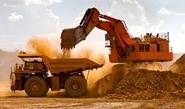Steel Products Prices North America

Cliffs Looks Forward to HBI Facility, Section 232 Action
Written by Sandy Williams
July 26, 2017
Cliffs Natural Resources is psyched to begin construction on its HBI facility. The company is currently in discussions with potential financial partners that align with Cliffs’ strategy for growth. CEO Lorenzo Goncalves says a financial partner for a $700 million private investment is not necessary to move the project forward, but would be nice to have.
The HBI plant to be constructed in Toledo, Ohio, will be fed by pellets from Cliffs’ own mines and will serve EAF mills in the Great Lakes region. Goncalves plans to run HBI production the same way the company does its iron ore pellets—reliable and consistent quality, tailor-made for each customer, he said. The facility will have a capacity of 1.6 million long tons and be completed in 2020. The HBI facility will expand Cliffs’ customer base to both blast furnace and EAF steelmakers, as well as providing a high margin outlet for 2.5 million long tons of its own pellets.
Goncalves attributed Cliffs’ location in the U.S. as a factor in its successful return to profitability. “The American business environment is predictable,” he said, “and we operate in a very mature economic and legal environment.” The three trade cases on hot rolled, cold rolled and coated steels were examples of “real action” that was implemented under the Obama administration.
“Some countries and some players within the United States did not get the underlying message of these three cases and continue to find ways to cheat the system. The next thing is the Section 232 investigation, self-initiated by the Trump administration. The Department of Commerce recognized the importance of steel to our national security, not just on defense-related products but on a lot of other things, from infrastructure to energy. While the 232 final determination has been delayed for reasons completely unrelated to the issue itself, we remain confident that some level of restrictive measure will be recommended soon. Even though Cliffs already has a strong business in the United States, going into the second half of the year, Section 232 should help our clients and make the second half even better for them. And that would be a positive for Cliffs, as well.”
Goncalves said he is pleased that some Australian ore producers are now focusing on higher value products and hopes BHP Billiton will soon follow suit. The selling of low-quality ore to traders who stockpile it at ports and then borrow money from China banks using the ore as collateral is an unwelcome cycle that hurts supply and pricing, said Goncalves. Cliffs’ sole Australian mine continues to provide cash flow, but there are no plans to expand the life of the mine, which should be depleted near the time the HBI facility comes online.
Cliffs Natural Resources reported net income from continuing operations of $77 million in the second quarter compared to $30 million in the same quarter in 2016. U.S. iron ore pellet sales volume in the second quarter of 2017 was 4.3 million long tons, a 4 percent increase when compared to the second quarter of 2016, as a result of increased customer demand.
Cliffs reduced its guidance to a conservative estimate of $310 million in net income for 2017, based on the current average price for hot rolled steel of $620 per ton maintaining its level through the end of the year.
“While during the second quarter we saw prices dip below $600, the back of the year is looking stronger,” said Goncalves. “Underlying steel demand continues to improve, but service centers insist on keeping inventories dangerously low. As the bad players continue to understand the threats of a Section 232 to themselves, and imports continue to disappear from the markets, panic buying from service centers and other steel consumers could rise as steel prices in the United States go up sharply and very quickly.”
In the second quarter of 2017, Cliffs reported total company adjusted EBITDA of $137 million, as much as the company made in the first half of last year, thanks to a significant increase in realized iron ore prices in the U.S.
“Our U.S. iron ore business is a beast,” said Goncalves. “In the second quarter, we reported a realized revenue rate of $97 per long ton with an adjusted EBITDA margin of 39 percent. This generated $162 million in adjusted EBITDA on just 4.3 million long tons.”

Sandy Williams
Read more from Sandy WilliamsLatest in Steel Products Prices North America

Nucor maintains plate prices, opens August order book
Nucor aims to keep plate prices flat again with the opening of its August order book.

Nucor CSP remains level at $900/ton
Nucor maintained its weekly list price for hot-rolled (HR) coil this week, following two consecutive increases.

Cliffs raises prices, seeks $950/ton for July spot HR
Cleveland-Cliffs plans to increase prices for hot-rolled (HR) coil to $950 per short ton (st) with the opening of its July spot order book. The Cleveland-based steelmaker said the price hike was effective immediately in a letter to customers dated Monday.

HRC vs. prime scrap spread widens in June
The price spread between HRC and prime scrap widened in June.

SMU price ranges: Steel prices rise in response to tariffs
Steel prices climbed for a second straight week across all five sheet and plate products tracked by SMU.
